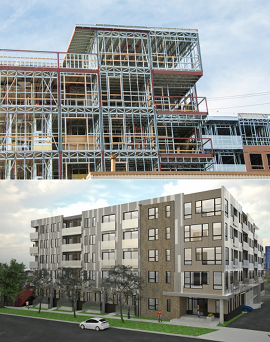
by Shane Henson — August 9, 2013—Software and structural system manufacturer Prescient recently announced the completion of the first building featuring its patent-pending technology, which uses an innovative light-gauge structural system consisting of a limited number of standardized light-gauge steel panels and cold-rolled steel elements. With the new technology, Prescient says it is able to deliver and install the structure of a building at a fraction of the cost and in a fraction of the time of wood, steel, or concrete.
“Standardized systems with flexibility, like Prescient, are the future of construction,” said Paul Books, president of Palisade Partners, the project’s developer. “Prescient has found an incredibly effective way to standardize every step of the process, from design to construction. It’s a first of its kind, and we are excited to be a part of the construction frontier.”
A new addition to the thriving Highlands neighborhood in Denver, The B Street LoHi building’s 60,000-square-foot, five-story apartment structure was installed in just six weeks—a production rate of over 15 thousand square feet per week, which is roughly three times faster than the average build time of a wood frame structure, the company claims.
“This first building is evidence that our standardized structural alternative allows complete design freedom while speeding up build time and reducing costs,” said John Vanker, CEO and co-founder of Prescient. “We’ve already begun installation on our second building and are currently bidding on active projects across the country of over 3.5 million square feet.”
Prescient’s next building, University Station, a six-story affordable housing complex near the University of Denver light rail station, is currently being erected. The building, viewable on a live Webcam, dovetails nicely with Denver Mayor Michael Hancock’s call for more affordable housing during his recent state of the city address, notes Prescient, and the framing is expected to be complete in an even faster time than the LoHi’s—in just five weeks.
In addition to living environments, Prescient says its system can be used in office and retail design and construction.




